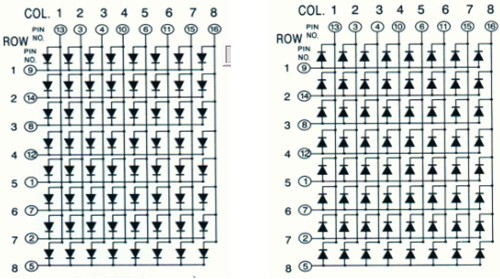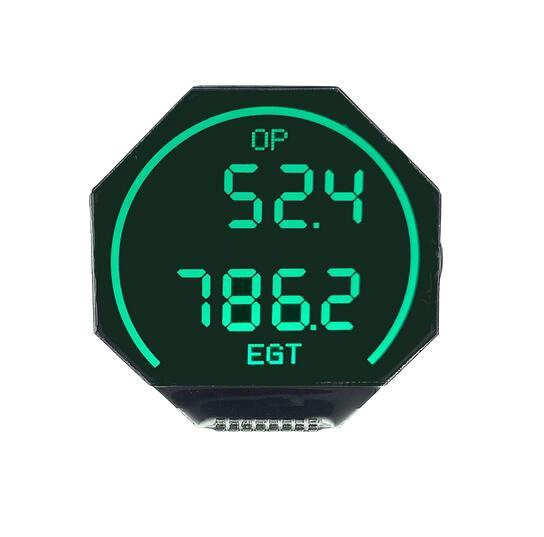In the world of digital display technology, segment displays and dot matrix displays are two basic and widely used types. Despite their seemingly simple functionality, they play a key role in many electronic devices. This article aims to delve into the technical details, differences, and respective application areas of these two types of screens.
I. Segment Display (Seven-Segment Display):
Segment displays are commonly used to display numbers and a limited set of characters. Their design is based on breaking down characters into a simple form made up of several segments.

Working Principle and Features:
1.Working Principle
Segment displays are based on a relatively simple display principle. They use a series of Light Emitting Diodes (LEDs) or Liquid Crystal Displays (LCDs) configured as “segments” to form numbers and limited characters.
Composition: A standard seven-segment display contains seven independent LED or LCD “segments,” each of which can be controlled individually. These segments are typically arranged in the shape of the number “8”.
Character Generation:By controlling which segments are lit or turned off, different numbers and some characters can be formed. For example, to display the number “2”, the top, middle, bottom, lower-left, and upper-right segments are lit.
Electronic Control: Segment displays are usually connected to a microcontroller or other forms of digital logic circuitry to control the state (i.e., lit or off) of each segment.
2.Features
Low Energy Consumption: As only a limited number of segments need to be lit to display characters, segment displays are excellent in terms of energy efficiency.
Easy to Read: Segment displays are clear and easy to read, even in poorly lit environments.
Design Limitations: Due to their inherent design, segment displays cannot show complex graphics or a complete set of characters.
II. Dot Matrix Display (Dot Matrix Display):
Dot matrix displays consist of a matrix of many small bulbs (pixels), each of which can be individually controlled.

Working Principle and Features:
1.Working Principle
Dot matrix displays are a more complex display technology. They consist of a matrix made up of many small bulbs (LEDs) or liquid crystal units (LCDs), each of which can be independently controlled to create detailed images and text.
Pixel Composition: The basic unit of a dot matrix screen is the pixel, each pixel being made up of one or more small bulbs (in LED screens) or liquid crystal units (in LCD screens).
Image Generation: By changing the state of each pixel (such as color and brightness), complex graphics and text can be created. In color displays, each pixel typically consists of red, green, and blue sub-pixels. By adjusting the brightness of these sub-pixels, different colors can be generated.
Control Mechanism: Dot matrix screens require complex electronic control systems to manage the state of each pixel. This is usually achieved through an Integrated Circuit (IC) that controls the entire screen's pixel array.
2.Features
High Flexibility: Dot matrix screens can display a variety of content, from simple text to complex images.
High Resolution: Because each pixel is controllable, dot matrix screens can achieve higher resolution and detail in display.
Higher Energy Consumption: Compared to segment displays, dot matrix screens require more energy to maintain the operation of a large number of pixels.
III.Comparison and Application:

1.Display Capability
Segment display: Its advantage lies in simplicity and directness, primarily used for displaying numbers and a limited set of characters. Due to its limited display capabilities, it is not suitable for showing complex graphics or lengthy text.
Dot Matrix Display: Offers a broader display capability, including complex graphics and various characters. It can display almost all types of content, from simple text to high-resolution images.
2.Resolution and Clarity
Segment Display: Typically only offers limited resolution as they are based on fixed “segments” to display content.
Dot Matrix Display: Due to the number and arrangement of its pixels, it can provide higher resolution and clarity, suitable for situations that require detailed image display.
3.Energy Consumption and Efficiency
Segment Display: Generally more energy-efficient as only a portion of the LED or LCD “segments” are activated at a given time.
Dot Matrix Display: Tends to consume more electricity as it requires controlling a larger number of pixels, especially in high brightness or full-color display.
4.Cost
Segment Display: Typically less expensive due to its simpler manufacturing and control.
Dot Matrix Display: More costly due to its complexity and higher manufacturing costs, especially in the case of high-resolution and large-sized screens.
5.Application Range
Segment Display: Mainly used in applications that require the display of numbers and simple characters, such as calculators, digital watches, price displays, etc.
Dot Matrix Display: Due to its high flexibility, it has a broader range of applications, including smartphones, TVs, billboards, vehicle displays, etc.
6.User Interaction and Versatility
Segment Display: Limited interactivity, mainly used for displaying static information.
Dot Matrix Display: Capable of supporting more complex user interactions, such as touch screen functionality, suitable for multimedia and interactive applications.
Segment displays and dot matrix displays each have their strengths and weaknesses, suitable for different application fields. Understanding the basic working principles and features of these two technologies is crucial for choosing the right display technology for specific applications. As technology advances, we can expect both types of display technology to continue to evolve to better meet future needs.
The 8 inch displays might be affected and delay for an accident.
This is the project management of how sinocrystal handle your customized project relate to displays.
New iPhone 13 Series will use On-Cell OLED Displays. And it that will be launched in the second half of this year will be exclusively supplied by Samsung Display (SDC)
A complete guide to LCD display connection methods, including SPI, I2C, RGB, MIPI, LVDS interfaces and physical mounting options. Learn how to connect monochrome and TFT LCDs to your development board or product housing.
This week, we had the pleasure of hosting an esteemed international client at our LCD display manufacturing facility in Dongguan. Guided by our team, the client visited key production areas such as the fully automated COG bonding line, backlight assembly area, full lamination workshop, and final product aging test section. They highly appreciated our production capacity, strict quality control, and engineering expertise. This visit strengthened mutual trust and set the stage for future collabora
The ILI9881C is a high-performance a-Si TFT LCD single-chip driver developed by ILI Technology Corp. With its excellent display performance and flexible configuration options, this driver meets the modern display device requirements for high resolution and color accuracy. This article will detail the supported resolutions, interfaces, and power supply voltage of the ILI9881C.
The GC9307, a TFT LCD driver with QVGA resolution, has gained widespread use among LCD module manufacturers since its launch. Sinocrystal are excited to share a series of practical insights we have gathered from using the GC9307 driver.